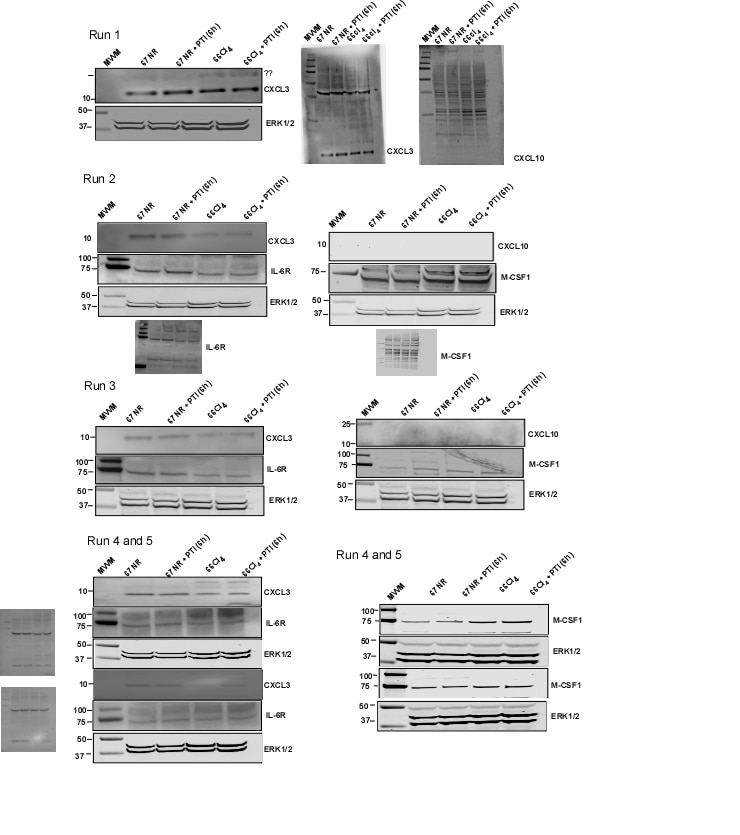Mouse CXCL3/GRO gamma /CINC-2/DCIP-1 Antibody Summary
Ala28-Ser100
Accession # AAI17017
Applications
Please Note: Optimal dilutions should be determined by each laboratory for each application. General Protocols are available in the Technical Information section on our website.
Scientific Data
 View Larger
View Larger
Chemotaxis Induced by CXCL3/DCIP‑1 and Neutral-ization by Mouse CXCL3/ DCIP‑1 Antibody. Recombinant Mouse CXCL3/DCIP-1 (Catalog # 5568-CA) chemo-attracts the BaF3 mouse pro-B cell line transfected with human CXCR2 in a dose-dependent manner (orange line). The amount of cells that migrated through to the lower chemotaxis chamber was measured by Resazurin (Catalog # AR002). Chemotaxis elicited by Recombinant Mouse CXCL3/ DCIP-1 (100 ng/mL) is neutralized (green line) by increasing concentrations of Sheep Anti-Mouse CXCL3/ DCIP-1 Antigen Affinity-purified Polyclonal Antibody (Catalog # AF5568). The ND50 is typically 0.5-3 µg/mL.
Preparation and Storage
- 12 months from date of receipt, -20 to -70 °C as supplied.
- 1 month, 2 to 8 °C under sterile conditions after reconstitution.
- 6 months, -20 to -70 °C under sterile conditions after reconstitution.
Background: CXCL3/GRO gamma/CINC-2/DCIP-1
CXCL3 is also known as MIP-2 beta (macrophage inflammatory protein 2 beta), or DCIP-1 (dendritic cell inflammatory protein-1) in mouse, CINC2 (cytokine-induced neutrophil attractant 2) in rat, and GRO-gamma (growth-regulated oncogene gamma) in humans (1, 2). It is an 8 kDa proinflammatory member of the CXC subfamily of heparin-binding chemokines, also called alpha chemokines (1‑4). The Glu-Leu-Arg (ELR) motif near the CXCL3 N-terminus confers angiogenic properties and distinguishes it from interferon-inducible ELR- CXC chemokines, which are angiostatic (4). ELR+ and ELR- chemokines use CXCR2 and CXCR3 receptors, respectively (3, 4). Mature mouse CXCL3 shares 88% and 57% amino acid (aa) sequence identity with rat and human CXCL3, respectively. Among mouse ELR+ chemokines, it shares 82% aa sequence identity with CXCL2/GRO-beta /MIP-2 and 34% - 58% with CXCL1/GRO-alpha /KC, CXCL5/ENA-78 and CXCL7/NAP-2. Due to their similar sequence and activity, CXCL2 and CXCL3 are sometimes referred to collectively as CXCL2/3, but are separate gene products (4‑6). Mouse CXCL3 expression is induced in macrophages and early in maturation of DC by bacterial products such as lipopolysaccharides, and other inflammatory mediators (1, 7). It is chemotactic for CXCR2‑expressing neutrophils, helping to recruit them to areas of inflammation (1, 7). ELR+ chemokines also elicit endothelial cell chemotaxis, stimulating angiogenesis and playing a role in tumor development (3, 4). ELR+ chemokines upregulated by ischemia play a role in ischemia-reperfusion injury (5, 6). A decoy receptor, DARC (Duffy antigen receptor for chemokines) competes with CXCR2 for ELR+ chemokine binding, thus downregulating their effect (8). Neutrophil influx may also be downregulated by MMP-12, which has been found to inactivate CXCL3 and other ELR+ chemokines by cleaving them at the ELR site (9). Over aa 28-100, mouse CXCL3 shares 87.8% aa identity with rat CINC2.
- Nolan, K. F. et al. (2004) J. Immunol. 172:2201.
- Modi, W. S. and T. Yoshimura (1999) Mol. Biol. Evol. 16:180.
- Vandercappellen, J. et al. (2008) Cancer Lett. 267:226.
- Strieter, R.M. et al. (2005) Cytokine Growth Factor Rev. 16:593.
- Nesmelova, I. V. et al. (2008) J. Biol. Chem. 283:24155.
- Maheshwari, A. et al. (2004) Fetal Pediatr. Pathol. 23:145.
- Furuichi, K. et al. (2008) Front. Biosci. 13:4021.
- Takano, K. and H. Nakagawa (2001) Inflamm. Res. 50:503.
- Horton, L. W. et al. (2007) Cancer Res. 67:9791.
Product Datasheets
Citations for Mouse CXCL3/GRO gamma /CINC-2/DCIP-1 Antibody
R&D Systems personnel manually curate a database that contains references using R&D Systems products. The data collected includes not only links to publications in PubMed, but also provides information about sample types, species, and experimental conditions.
4
Citations: Showing 1 - 4
Filter your results:
Filter by:
-
KRAS-IRF2 Axis Drives Immune Suppression and Immune Therapy Resistance in Colorectal Cancer
Authors: Wenting Liao, Michael J. Overman, Adam T. Boutin, Xiaoying Shang, Di Zhao, Prasenjit Dey et al.
Cancer Cell
-
Integrated multi-omics profiling reveals neutrophil extracellular traps potentiate Aortic dissection progression
Authors: Zhao, YF;Zuo, ZA;Li, ZY;Yuan, Y;Hong, SC;Fu, WG;Zhou, B;Wang, LX;
Nature communications
Species: Mouse
Sample Types: In Vivo
Applications: In vivo assay -
Stromal reprogramming through dual PDGFRalpha/beta blockade boosts the efficacy of anti-PD-1 immunotherapy in fibrotic tumors
Authors: T Akiyama, T Yasuda, T Uchihara, N Yasuda-Yos, BJY Tan, A Yonemura, T Semba, J Yamasaki, Y Komohara, K Ohnishi, F Wei, L Fu, J Zhang, F Kitamura, K Yamashita, K Eto, S Iwagami, H Tsukamoto, T Umemoto, M Masuda, O Nagano, Y Satou, H Saya, P Tan, H Baba, T Ishimoto
Cancer Research, 2023-03-02;0(0):.
Species: Mouse, Transgenic Mouse
Sample Types: Whole Cells
Applications: Neutralization -
CXCR4-dependent macrophage-to-fibroblast signaling contributes to cardiac diastolic dysfunction in heart failure with preserved ejection fraction
Authors: N Zhang, Q Ma, Y You, X Xia, C Xie, Y Huang, Z Wang, F Ye, Z Yu, X Xie
International journal of biological sciences, 2022-01-09;18(3):1271-1287.
Species: Mouse
Sample Types: Whole Cells
Applications: Bioassay
FAQs
No product specific FAQs exist for this product, however you may
View all Antibody FAQsReviews for Mouse CXCL3/GRO gamma /CINC-2/DCIP-1 Antibody
Average Rating: 2 (Based on 1 Review)
Have you used Mouse CXCL3/GRO gamma /CINC-2/DCIP-1 Antibody?
Submit a review and receive an Amazon gift card.
$25/€18/£15/$25CAN/¥75 Yuan/¥2500 Yen for a review with an image
$10/€7/£6/$10 CAD/¥70 Yuan/¥1110 Yen for a review without an image
Filter by:


